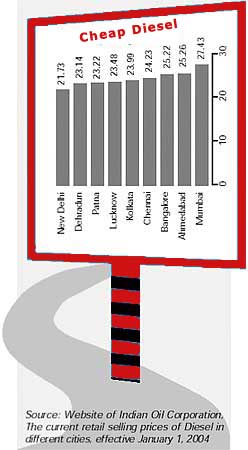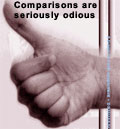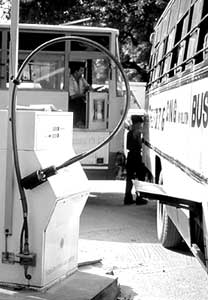 |
The ex-showroom price of a diesel car is higher than that of a petrol car, but the difference is so narrow that it hardly deters the consumer from preferring diesel-run Cheap Diesel vehicles No. Neither is industry New strategies are redefining the diesel car market. See, for instance, what Skoda India has done. Their entry into the Indian market was unique: contrary to trends, the price of the petrol version and the diesel version was the same. Consider the effect of such a strategy on the consumer, who would now naturally be inclined to go for the latter. Indeed, companies are not chary of even reversing the trend: among Tata Safari’s top end models, the price of the petrol versions are higher than the diesel ones (See timeline: Diesel car models since 1998). Customers, understandably, are spoilt for choice. |
|
|
ALL ABOUT GUZZLING: Fuel trends in Delhi |
 |
Indeed, dieselisation is worsening. Some of the largest carmakers, that had hitherto stayed away from diesel versions, are now preparing to aggressively enter the diesel market. Maruti Udyog Ltd (MUL) is setting up a diesel engine assembly plant at Gurgaon near Delhi. Diesel cars are about 5 per cent of the total MUL production and MUL currently imports its diesel engines. Hyundai Motor India Ltd is all poised to roll out a diesel version of one of its most popular model, the Santro. The Indian unit of Italy’s Fiat Auto Spa also plans to introduce a new diesel Sedan in April 2004: apparently, the diesel Sedan will be powered by the same 1.9 litre engine that powers its flagship Palio hatchback and the Adventure estate and will be called the Petra.
| Diesel car models since 1998 (Years are indicative) | ||||||
| 1998 | 1999 | 2000 | 2001 | 2002 | 2003 | 2004 |
 Tata Indica (Costlier by only Rs 16,000 than petrol version) Rs 78,099 than petrol version) |
 |
 |
 (Priced same as the petrol version) Bolero |
 by around Rs 17,000 than petrol version) |
 |
 |
Going by the plans Indian automobile manufacturers are gleefully hatching, the future looks bleakly dieselised. Let us understand that in India, the quality of diesel used is extremely poor. Moreover, the Indian government is not interested in providing cleaner diesel. In such a scenario, the effect more diesel cars on Indian roads are going to have is absolutely disastrous.
 |
• Entire city bus fleet should be converted to CNG |
||
|
|||
 If dieselisation of the car fleet is now allowed to continue unchecked, Delhi will undo the gains from the CNG programme. |
|||

